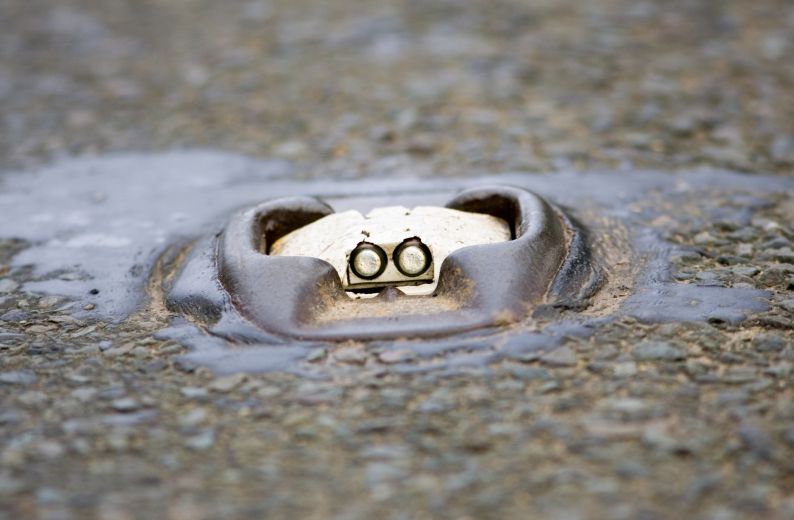This is especially true for learner drivers who are trying to get an understanding of what all the various road signs and markings mean when they get behind the wheel.
In fact, these studs will appear in a driving theory test. There are a variety of studs on the motorway that can mean different things.
In the UK, these studs will become an important part of your daily drive, and this guide gives you all the information you need for your future as a driver.
What are reflective studs on the motorway?
Also known as cat’s eyes, reflective studs are small, raised markers located in the centre of a motorway lane.
They are used to provide a visual reference for drivers and to help guide them in the dark, low light and wintry conditions.
The reflective studs are plastic casings that are embedded with glass beads or retro-reflective material that can be easily spotted after light reflects from vehicle’s headlights.
Reflective studs are used to mark the edge of a motorway lane, central reservation, indicate a lane change, or mark where you can drive.
The studs come in a variety of colours and are spaced out along the road. It is a vital safety feature for the motorways.
These studs also appear on dual carriageways, A and B roads, roundabouts, junctions, lay-bys, and other areas of the road network.
Why do motorways have reflective studs?
Reflective studs are a common sight on motorways and are designed to help drivers stay in the correct lane and improve visibility in poor weather or darkness.
Another important reason for using reflective studs on motorways is to help drivers spot upcoming changes in the road, so that they can adjust accordingly.
This is especially important in areas with a high speed limit, as drivers may not have time to react to sudden changes in the road if they don’t spot them in time. The reflective studs help drivers to spot these changes in the road ahead and adjust their speed accordingly.
In addition to helping drivers stay in the correct lane and spot upcoming bends, reflective studs can also help to reduce the risk of accidents. By providing an increased level of visibility, these studs can help drivers to spot any potential hazards before they reach them, allowing them to take the necessary precautions.
The studs themselves work at any time of the day or night and have become widespread across the modern world.
Why is it important to learn what motorway reflective studs mean?
Motorways are where vehicles move the fastest. With limits of 70mph and with multiples lanes, they provide challenges for drivers, that are made easier by having reflective studs.
This is why there are theory test questions on this topic, as their importance – and in the name of safety – all drivers should know what they mean.
Extra information provided by the colour and placement of the studs means divers can make the correct decision earlier. Understanding the meaning of the different types of reflective studs can help drivers identify potential hazards ahead.
You might want to consider a theory test practice app. Driving Theory Test UK is a great place to start, with all necessary learning materials, hazard perception clips and Highway Code info included. You can download it here:
Motorway reflective stud colours
Below are the main colours you will find when driving on a UK motorway. These reflective studs will mean different things, so knowing the difference is important for learner, new or experienced drivers.
Green
These reflective motorway studs signify the beginning or the end of a slip road. These ensure that drivers can identify the route you need to take on or off the motorway. In challenging visual situations, these studs show when someone can indicate to leave a main carriageway.
Green studs also show where lay-bys are on motorways and A roads.
They can also show drivers when there are temporary changes to the layout of the road, when longer-term roadworks are happening.
Red
When you are in the left hand lane, these reflective studs show where drivers can’t travel over the lines into the hard shoulder.
In misty or wintry conditions, they will show where you should remain in the main three lanes and not veer into a lane which should be clear at all times.
Amber
In the third lane, you may see amber coloured reflective studs. These show the line that shouldn’t be crossed into the central reservation.
Much like the red studs, these are in place to help drivers know where the lines between the third lane and the central reservation are in low light and difficult weather conditions.
White
These are the most common reflective studs you will see on UK motorways. These simply show where each of the three lanes are in challenging driving conditions.
You will also see these across many other types of roads to show the boundaries of driving lanes.
Fluorescent Green and Yellow Studs
Alternatively, these are one of the least common reflective studs that can be seen on the motorway.
These show that there have been changes to the road ahead, or that roadworks are currently taking place.
If you are a learner driver, then the thought of driving on a motorway might seem daunting. But don’t fear! We have an extensive guide for learner drivers on the motorway, that helps explain what you can expect.












